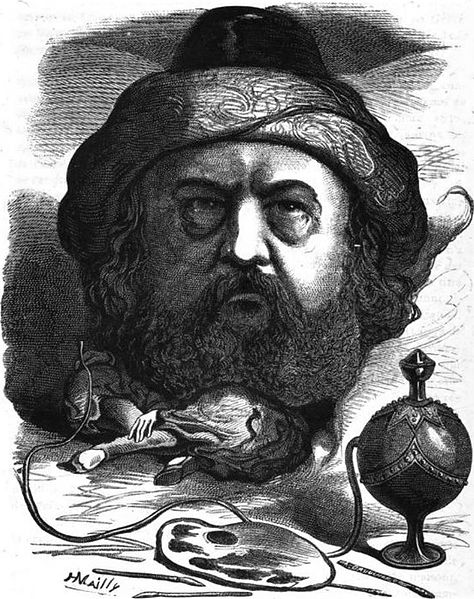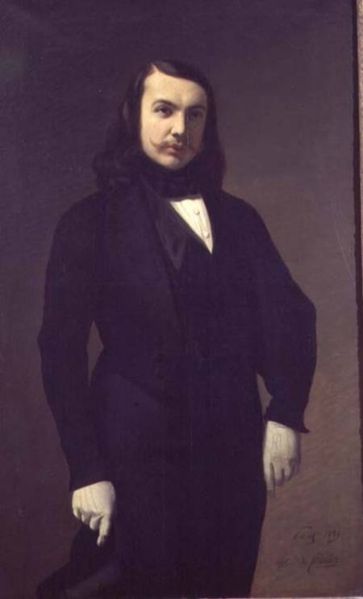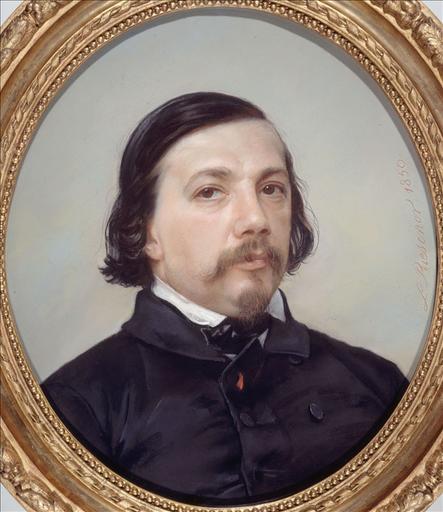<Back to Index>
- Mathematician Olga Taussky - Todd, 1906
- Writer Pierre Jules Théophile Gautier, 1811
- General of the Vendéan Army Henri du Vergier, comte de Rochejaquelein, 1772
PAGE SPONSOR
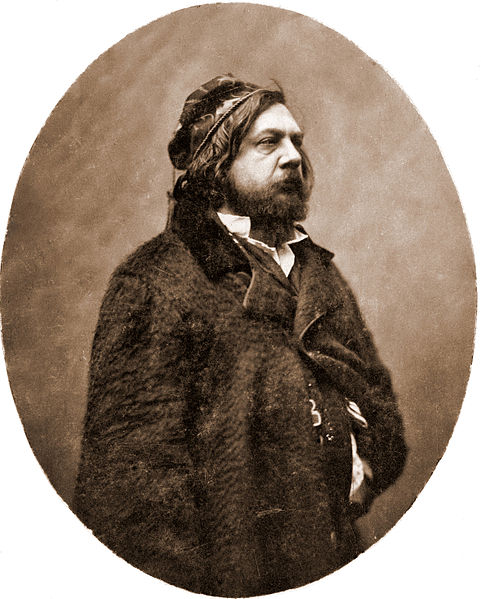
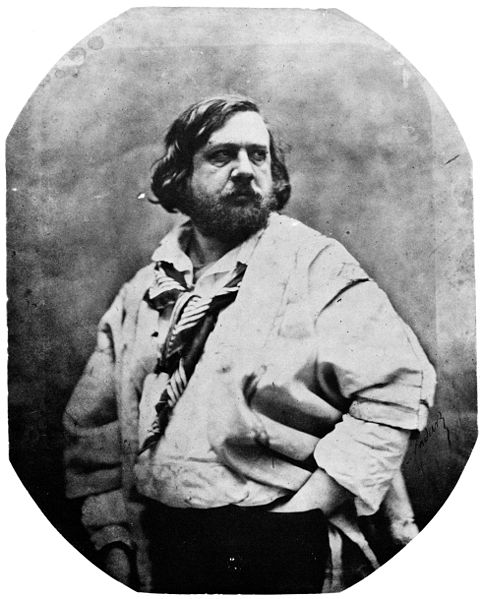
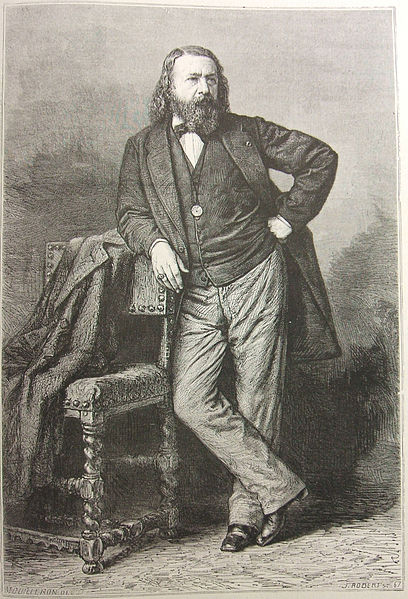
Pierre Jules Théophile Gautier (August 30, 1811 – October 23, 1872) was a French poet, dramatist, novelist, journalist, art critic and literary critic.
While Gautier was an ardent defender of Romanticism, his work is difficult to classify and remains a point of reference for many subsequent literary traditions such as Parnassianism, Symbolism, Decadence and Modernism. He was widely esteemed by writers as diverse as Balzac, Baudelaire, the Goncourt brothers, Flaubert, Proust and Oscar Wilde. Gautier was born on August 30, 1811, in Tarbes, capital of Hautes - Pyrénées département in southwestern France.
His father, Pierre Gautier, was a fairly cultured minor government
official and his mother was Antoinette - Adelaïde Concarde. The
family moved to Paris in 1814, taking up residence in the ancient Marais district. Gautier's education commenced at the prestigious Collège Louis - le - Grand in Paris (fellow alumni include Voltaire and Charles Baudelaire),
which he attended for three months before being brought home due to
illness. Although he completed the remainder of his education at Collège Charlemagne (alumni include Charles Augustin Sainte - Beuve), Gautier's most significant instruction came from his father, who prompted him to become a Latin scholar by age 18. While at school, Gautier befriended Gérard de Nerval and the two became lifelong friends. It is through Nerval that Gautier was introduced to Victor Hugo, by then already a well known, established leading dramatist and author of Hernani.
Hugo became a major influence on Gautier and is credited for giving
him, an aspiring painter at the time, an appetite for literature. It was
at the legendary premier of Hernani that Gautier is remembered for
wearing his anachronistic reddoublet. In the aftermath of the 1830 Revolution, Gautier's family experienced hardship and was forced to move to the outskirts of Paris. Deciding to experiment with his own independence and freedom, Gautier
chose to stay with friends in the Doyenné district of Paris,
living a rather pleasant bohemian life. Towards the end of 1830, Gautier began to frequent meetings of Le Petit Cénacle, a group of artists who met in the studio of Jehan Du Seigneur. The group was a more irresponsible version of Hugo's Cénacle. The group counted among its members the artists Gérard de Nerval, Alexandre Dumas, père, Petrus Borel, Alphonse Brot, Joseph Bouchardy and Philothée O’Neddy (real name Théophile Dondey). Le Petit Cénacle soon gained a reputation for extravagance and eccentricity, but also for being a unique refuge from society. Gautier
began writing poetry as early as 1826 but the majority of his life was
spent as a contributor to various journals, mainly La Presse,
which also gave him the opportunity for foreign travel and for meeting
many influential contacts in high society and in the world of the arts.
Throughout his life, Gautier was well traveled, taking trips to Spain, Italy, Russia, Egypt and Algeria. Gautier's many travels inspired many of his writings including Voyage en Espagne (1843), Trésors d’Art de la Russie (1858), and Voyage en Russie (1867). Gautier's travel literature is
considered by many as being some of the best from the nineteenth
century, often written in a more personal style, it provides a window
into Gautier's own tastes in art and culture. Gautier was a celebrated abandonnée of the Romantic Ballet, writing several scenarios, the most famous of which is Giselle, whose first interpreter, the ballerina Carlotta Grisi,
was the great love of his life. She could not return his affection, so
he married her sister Ernestina, a singer. He was also a great lover of
cats. Absorbed
by the 1848 Revolution, Gautier wrote almost one hundred articles,
equivalent to four large books, within nine months in 1848. Gautier
experienced a prominent time in his life when the original romantics
such as Hugo, François - René de Chateaubriand, Alphonse de Lamartine, Alfred de Vigny and Alfred de Musset were no longer actively participating in the literary world. His prestige was confirmed by his role as director of Revue de Paris from 1851 - 1856. During this time, Gautier left La Presse and became a journalist for Le Moniteur universel,
finding the burden of regular journalism quite unbearable and
"humiliating." Nevertheless, Gautier acquired the editorship of the
influential review L’Artiste in 1856. It is through this review that Gautier publicized Art for art's sake doctrines through many editorials. The 1860s were years of assured literary fame for Gautier. Although he was rejected by the French Academy three times (1867, 1868, 1869), Charles - Augustin Sainte - Beuve,
the most influential critic of the day, set the seal of approval on the
poet by devoting no less than three major articles in 1863 to reviews
of Gautier's entire published works. In 1865, Gautier was admitted into
the prestigious salon of Princess Mathilde Bonaparte, cousin of Napoleon III and niece to Bonaparte.
The Princess offered Gautier a sinecure as her librarian in 1868, a
position that gave him access to the court of Napoleon III. Elected in 1862 as chairman of the Société Nationale des Beaux - Arts, he was surrounded by a committee of important painters: Eugène Delacroix, Pierre Puvis de Chavannes, Édouard Manet, Albert - Ernest Carrier - Belleuse and Gustave Doré. During the Franco - Prussian war,
Gautier made his way back to Paris upon hearing of the Prussian advance
on the capital. He remained with his family throughout the invasion and
the aftermath of the Commune, eventually dying on October 23, 1872 due
to a long standing cardiac disease. Gautier was sixty - one years old. He
is interred at the Cimetière de Montmartre in Paris. Early in his life, Gautier befriended Gérard de Nerval, who influenced him greatly in his earlier poetry and also through whom he was introduced to Victor Hugo. He shared in Hugo's dissatisfaction with the theatrical outputs of the time and the use of the word "tragedy." Gautier admired Honoré de Balzac for his contributions to the development of French Literature. As Gautier started off as a painter before he was a writer, he found many
artists to be influential in his view of art itself. Painters such as
the French artist, Jean - Auguste - Dominique Ingres, who chose only to paint when inspired, and Spanish painters such as Murillo, Velázquez and Ribera significantly informed his work and views. Gautier
was influenced greatly by his friends as well, paying tribute to them
in his writings. In fact, he dedicated his collection of Dernières Poésies to his many friends, including Hérbert, Madame de la Grangerie, Maxime du Camp and of course, Princess Mathilde Bonaparte. Gautier spent the majority of his career as a journalist at La Presse and later on at Le Moniteur universel.
He saw journalistic criticism as a means to a middle class standard of
living. The income was adequate and he had ample opportunities to
travel. Gautier began contributing art criticisms to obscure journals as
early as 1831. It was not until 1836 that he experienced a jump in his
career when he was hired by Emile de Girardin as an art and theatre columnist for La Presse. During his time at La Presse, however, Gautier also contributed nearly 70 articles to Le Figaro. After leaving La Presse to work for Le Moniteur universel, the official newspaper of the Second Empire,
Gautier wrote both to inform the public and to influence its choices.
His role at the newspaper was equivalent to the modern book or theatre
reviewer. Gautier's
literary criticism was more reflective in nature, criticism which had
no immediate commercial function but simply appealed to his own taste
and interests. Later in his life, he wrote extensive monographs on such
giants as Gérard de Nerval, Balzac, and Baudelaire, who were also his friends.
Gautier,
who started off as a painter, contributed much to the world of art
criticism. Instead of taking on the classical criticism of art that
involved knowledge of color, composition and line, Gautier was strongly
influenced by Denis Diderot's
idea that the critic should have the ability to describe the art so as
the reader can "see" the art through his description. Many other critics
of the generation of 1830 took on this theory of the transposition of
art – the belief that one can express one art medium in terms of
another. Although today Gautier is less well known as an art critic than
his great contemporary, Baudelaire, he was more highly regarded by the painters of his time. In 1862 he was elected chairman of the Société Nationale des Beaux - Arts (National Society of Fine Arts) with a board which included Eugène Delacroix, Édouard Manet, Gustave Doré and Pierre Puvis de Chavannes.
Gautier's literary criticism was
more reflective in nature; his literary analysis was free from the
pressure of his art and theatre columns and therefore, he was able to
express his ideas without restriction. He made a clear distinction
between prose and poetry, stating that prose should never be considered
the equal of poetry. The bulk of Gautier's criticism, however, was
journalistic. He raised the level of journalistic criticism of his day.
The
majority of Gautier's career was spent writing a weekly column of
theatrical criticism. Because Gautier wrote so frequently on plays, he
began to consider the nature of the plays and developed the criteria by
which they should be judged. He suggested that the normal five acts of a
play could be reduced to three: an exposition, a complication, and a dénouement. Having abandoned the idea that tragedy is the superior genre, Gautier was willing to accept comedy as the equal of tragedy. Taking it a step further, he suggested that the nature of the theatrical effect should be in favour of creating fantasy rather than portraying reality because realistic theatre was undesirable. From a 21st century standpoint Gautier's writings about dance are the most significant of his writings. The American writer Edwin Denby,
widely considered the most significant writer about dance in the 20th
century, called him "by common consent the greatest of ballet critics."
Gautier, Denby says, "seems to report wholly from the point of view of a
civilized entertainment seeker." He founds his judgments not on
theoretical principles but in sensuous perception, starting from the
physical form and vital energy of the individual dancer. This emphasis
has remained a tacit touchstone of dance writing ever since. Through his
authorship of the scenario of the ballet Giselle,
one of the foundation works of the dance repertoire, his influence
remains as great among choreographers and dancers as among critics and
balletomanes.
Gautier
did not consider himself to be dramatist but more of a poet and
storyteller. His plays were limited because of the time in which he
lived. During the Revolution of 1848,
many theatres were closed down and therefore plays were scarce. Most of
the plays that dominated the mid - century were written by playwrights
who insisted on conformity and conventional formulas and catered to
cautious middle class audiences. As a result, most of Gautier's plays
were never published or reluctantly accepted.
